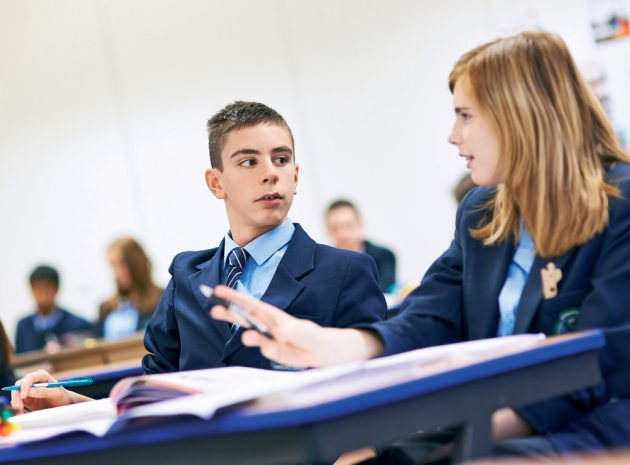Inspire your learners towards more creative thinking and more ambitious articulation, by giving them a mystery to solve, suggests Lidewei Simmons…
Creating a mystery scenario in an MFL lesson is a very effective and engaging metacognitive activity that is highly versatile and can be incorporated into any given topic. Students work in groups and use problem-solving, analysis and decision-making techniques to investigate a mystery or to explore a particular question using information or ‘clues’ to help them do this. After reading all the evidence, their aim is to attempt to answer the chosen question in the target language, with a measured justification. As this is an open task, the activity encourages students to produce a broad range of reasoned arguments based on knowledge and understanding of an issue, as well as getting into the habit of using reliable evidence to support their ideas. engagement with the topic.
Contentious issues are often a good way to trigger heated debates, not only encouraging pupils to consider their own thoughts, opinions and feelings around a topical issue but also giving students the chance to discuss and reflect upon each others’ answers and justifications.
Mystery based activities of this kind are extremely versatile and can therefore be used across a range of subjects and with groups of mixed abilities encouraging a variety of thinking skills such as synthesising, speculating, classifying and sequencing.
I recently taught a unit on Healthy Living to my Year 11 Spanish group and used the question “Why has María become anorexic?” as the focus of my mystery. The statements surrounding this question included a range of high-level topic-specific vocabulary as well as a variety of tenses and opinions. As I have a mixed ability class, I varied the level of Spanish so that all students could access the language and become involved in the activity.
I introduced my objectives and purposely chose a starter activity which involved thinking skills. Students were given 20 cards each with a different noun or adjective relating to the topic of healthy living. Working in pairs, the students were then given seven minutes to classify these words into groups. They could choose how to do this themselves but were told they would have to justify their choices afterwards. Some of the vocabulary had been taught and some had not. After the time had elapsed each pair joined with another pair and compared their lists and described to one another their reasons for the groupings. Interestingly, students chose a range of different strategies to classify areas of language, ranging from classification according to spelling patterns, meaning, gender, cognates and personal opinions – these were the results I had hoped for, especially as pupils used lots of technical language to explain their choices.
Encountering and evaluation
I arranged my students into groups of four – each group contained students of mixed gender, ability and types of learner. I introduced the central question of the lesson “Why has María become anorexic?“and informed the groups that they were all required to be actively involved in the lesson by acting as detectives to solve the mystery.
I handed out envelopes containing evidence (i.e. statements in Spanish containing information about Maria and her life) and told each group that by reading and analysing this and deciding what was/wasn’t relevant, they were to collaboratively establish an answer to the question. Each envelope contained 20 statements, which included information such as character background and description, character action/scenario/relationships and some deliberate ‘red herrings’’designed to mislead pupils if they were not prepared to reason and evaluate.
Students’ thinking processes were physically evident as they moved the pieces of paper around on the table. This demonstrated that they were simultaneously sharing their reasoning as well as progressing in their thinking. I encouraged them to use any other information and vocabulary they already knew to formulate their arguments. I emphasised that reflection on how they had arrived at a particular solution was more important than the solution itself.
Throughout the bulk of the lesson, I assumed the role of a mediator and monitored the progress of each group and tried to keep them on the right footing by posing prompt questions. I asked them questions such as “Does this card link with another?”, “Why is this becoming an important category?”, “What does this mean?” “Are these statements useful?” and “What are you arguing?” to keep encouraging them to think about what they were doing.
I then asked all students to debrief to the class as a whole (this could be done via a spokesperson) by voicing and justifying their groups’ arguments and theories to the rest of the class in Spanish.
The students were very engaged and focused throughout the task. There was excellent collaboration between each group when discussing their reasoning. Some groups found it difficult to eliminate unnecessary information and sometimes found it hard to infer meaning based on evidence and needed guiding with their thinking and reasoning.
Summary
Mysteries can be used at any linguistic level to cross-examine any social or current issue in the target language. They are excellent for teaching skills such as skimming and scanning, and reading for detail. They also encourage students to sort the relevant from the irrelevant as well as inviting them to search collaboratively for evidence, making links between contrasting pieces of language and inferring meaning from these – all skills that can be applied to other subjects. It is important that all students understand what they have done during the lesson and the skills they have honed and developed by tackling an open-ended question.
Home learning
Students can be asked to write a story based on what they have learnt from the question. Alternatively, you could ask students to create a ‘Go animate’ video (a video with cartoons) or a ‘Voki’( an educational tool that allows students to create their own talking character) to log and document all their thoughts and discussions from the lesson and to create interesting and memorable presentations which consolidate their learning.
About the author
Lidewei Simmons is currently acting subject leader for MFL at JFS and has been a Spanish and French teacher in the school for the past five years. A graduate of University College, London with a BA Joint Honours degree in Spanish and Dutch, she has travelled extensively and is passionate about languages and immersing herself in
Try this
An idea to stretch more able learners would be to make these students ‘experts’ and to ask one ‘expert’ from a group to swap with another ‘expert’ from another so that ideas and explanations can be put under scrutiny and hence help to develop pupils’ reasoning skills.










Inspire your learners towards more creative thinking and more ambitious articulation, by giving them a mystery to solve, suggests Lidewei Simmons…